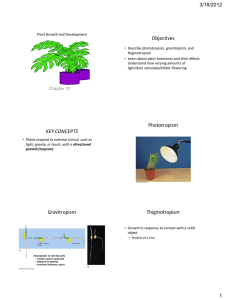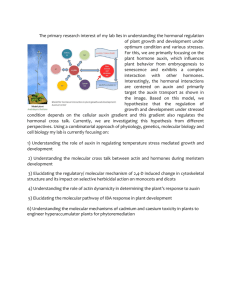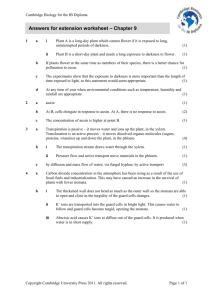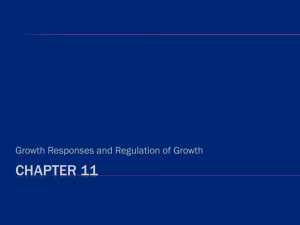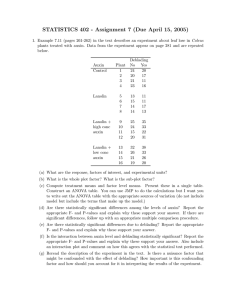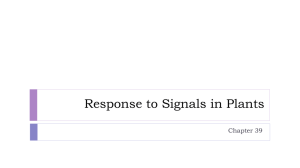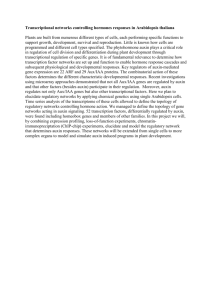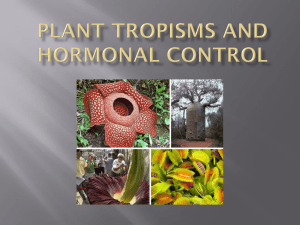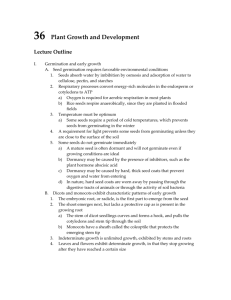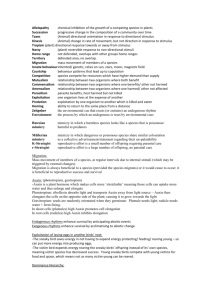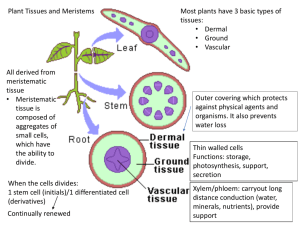Plant Growth and Hormones
advertisement
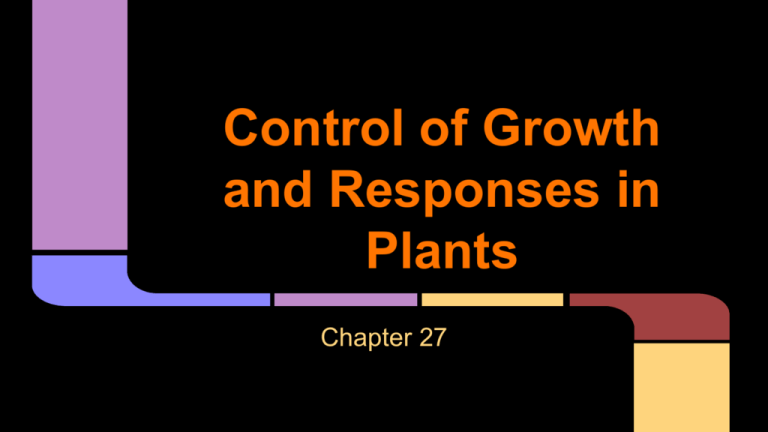
Control of Growth and Responses in Plants Chapter 27 Plant Responses Tropism ● Plant growth away or toward a unidirectional stimulus o due to differential growth There are three well known types of tropism. Phototropism ● Positive o cells on the shady side of a stem elongate ● Negative o roots curve away from light Riboflavin- acts as a photoreceptor Auxin- migrates to the shady side of a stem from the bright side. Gravitropism ● Positive o roots grow in the direction of gravity if root caps are removed, roots no longer respond to gravity ● contain statoliths- starch grains within amyloplasts o amyloplasts come in contact with ER and lead to pumping of auxin into the cell auxin inhibits the growth of root cells and the upper surface elongates ● Negative o stems grow opposite the pull of gravity auxin stimulates the growth of stem cells and the lower surface elongates Thigmotropism Unequal growth due to contact with solid objects ● Cells on the object grow less, while the other side elongates Auxin and ethylene can induce curvature Thigmomorphogensis Touch response that the entire plant responds to environmental stimuli. Nastic Movements Do not involve growth and are not dependent on the direction of stimulus A single stimulus can cause all leaves to respond. This indicates a form of communication within the plant. Sleep Movement Type of nastic movement Response to changes in light (day vs. night) Circadian Rhythm - biological rhythm with 24 hour cycle - may persist without appropriate environmental cues - Biological clock maintains circadian rhythm - CAM plants Plants secrete nectar at the same time Flowers opening during the day, closing at night Plant Hormones Almost all communication in a plant is done by hormones. Hormones are made or stored in one part of a plant. They travel through phloem or from cell to cell in response to stimuli. Auxins ● There are different types of auxin o The most common is Indoeacetic acid (IAA) It is produced in shoot apical meristems and in young leaves, flowers, and fruits. ● Auxins affect many aspects of plant growth and development o May be applied to plant cuttings to stimulate root formation Effects of Auxin ● Apical dominance- apically produced auxin prevents the growth of lateral buds ● Can cause woody plants to grow adventitious roots quickly ● Production by seeds promotes fruit growth ● Synthetic auxin can be sprayed on plants to cause fruit to grow without fertilization (seedless tomatoes, watermelon grapes) Effects of Auxin ● Agent Orange ● Involved in phototropism and gravitropism How Auxins Work 1. Auxin binds to a plasma membrane receptor 2. Second messengers: a. activate an ATP driven H+ pump. As hydrogen ions are pumped out of the cell, the cell becomes acidic, loosening the cell wall, and enabling elongation b. stimulate the golgi to discharge transport vesicles carrying cell wall materials c. stimulate DNA binding protein that enters the nucleus and activates a gene to produce growth factors Gibberellins Growth-promoting hormones that bring about internode elongation of stem cells. There are at least 70 different gibberellins. The most common is gibberellic acid, GA3. Gibberellins Use ● ● ● ● ● Break dormancy of buds and seeds Bring onset of flowering in plants Increase flower size produce larger seedless grapes improve rice production Cytokinins Class of hormones that promote cell division May also prolong the life of flower cuttings and vegetables in storage. Senescence Aging process when a leaf loses its color. During senescence, large molecules are broken down and transported to other parts of the plants. This does not always affect the entire plant Cytokinin cans prevent leaf death and initiate their growth. Abscisic Acid (ABA) Stress hormone - Initiates and maintains seed and bud dormancy - Brings about the closure of stomata Ethylene - Involved in abscission - Stimulates enzymes, like cellulase, to cause leaf, fruit, or flower drop - Used in agriculture to - hasten ripening increase female flowers Photoperiodism Photoperiodism is a physiological response prompted by changes in the length of day or night. It may induce flowering in the spring or flowering in the fall. Types of plants Short-Day Plants - Flower when the day length is shorter than critical length Long-Day Plants - Flower when the day length is longer than a critical length Day-Neutral Plants - Flowering is not dependent on day length Phytochrome Blue-green leaf pigment that exists in 2 forms - Phytochrome red - Phytochrome far-red Far-red is converted to red during the night. This conversion may be the first step in a pathway that results in flowering. Phytochrome Functions Red to Far-red conversion controls growth functions. Far-red promotes seed generation and inhibits stem elongation. It also leads to the activation of regulatory proteins in the cytoplasm.
